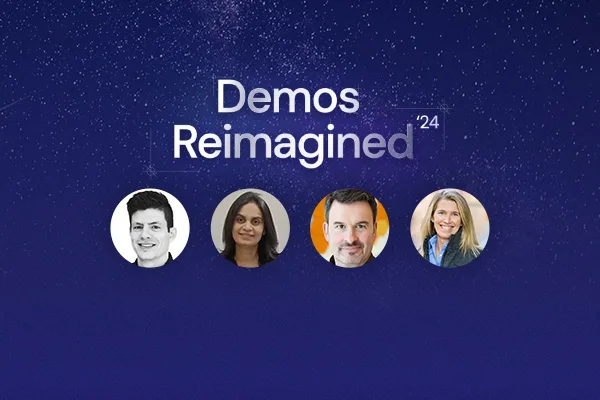Accelerate deals and increase win rates with the leading enterprise demo platform.
Demo Programs That Deliver: Shopify & More

February 10, 2025
Table of Contents
For go-to-market leaders across presales, marketing, and sales – especially those looking to infuse product experiences across the customer journey – last week’s Demos Reimagined event was one-of-a-kind. The 4-hour virtual event tackled a range of relevant topics, such as how presales teams can be more influential; best practices for establishing and scaling demo programs; getting budget and building the best teams; and avoiding demo fails.
If you missed it, don’t worry! All of the sessions are available on demand. But if you’re tight on time and want the reader’s digest of one of the most popular sessions of the day – Reimagining Demos: Inspiring Programs and How to Gain Support for One in Your Business – we’re here to deliver.
I had the opportunity to moderate this dynamic discussion that featured demo program leads at leading SaaS companies:
- Anjali Gattani, Senior Director of Demo Operations and Architecture at ServiceNow
- Andrei Dumitriu, Senior Manager of Revenue Technology at Shopify
- Patrick Hubbard, Director of Technical Product Marketing at ScienceLogic
While each of the speakers brought shared context around building and owning demo programs, they offered unique perspectives given their different roles in each organization: Anjali represented Presales, Andrei shared insights from a revenue operations POV, and Patrick weighed in from marketing.
The session dove into specifics around building demo programs and shared tips for success at each phase of maturity. Here are some of the highlights.
But first – what do we mean by “demo program”? At Reprise, we define a demo program as a top-down approach to building, centralizing, sharing, and analyzing demos. Demo programs bring organization and governance to demos, improving presales efficiency and making it easier for prospects to experience your product at every phase of buyers journey.
Phase 1: Getting Started
If your organization’s current approach to demos seems very bespoke, reactive, and disconnected, you aren’t alone. You also aren’t alone if the idea of formalizing a demo program seems daunting. Luckily Anjali, Andrei and Patrick shared tangible advice to get your demo program off the ground.
Start with simple wins
Patrick from ScienceLogic said that when you have multiple stakeholders with different constituents and they all need access to demo content, it’s important to think from the beginning about how you’ll be able to reuse the same content to support 80% of use cases. And then pick the team that’s most excited about demos as a starting point, to easily foster organic momentum.
Andrei from Shopify agreed, emphasizing the importance of focusing on “low-hanging fruit” first. At Shopify, this meant starting with “leave-behind” demos, which required little training to use while delivering high-value analytics about prospects’ engagement, arming reps with insights so they knew when to follow up and how.
ServiceNow took a phased approach, starting with those that would meet what they call a “one to many” ratio – demos that would be built by one group, but used by many.
Phase 2: Gaining Traction
Make demos easy to find and use
Shopify set out with one mission for their demo program: to enable everyone at Shopify—sales, support, product, and engineering—to demo confidently. Their initial leave-behind demos were easy for teams to adopt and required minimal training, making them accessible across all departments.
Likewise, ServiceNow’s demo strategy follows three tenets – “Find, Learn, Deliver” – reflecting their focus on making demos accessible to the hundreds of solutions consultants on their team in addition to executives and other stakeholders.
Patrick highlighted the value of extensive enablement training, noting the importance of clear pathways and stories accompanying each demo. ScienceLogic even integrated enablement training with each demo to ensure anyone could follow the click paths and storytelling—making it an efficient, self-serve resource.
Foster collaboration across teams
Shopify makes demos fun and fuels collaboration with gamification. Their sales enablement team developed a badging system that certifies employees on certain demos before granting access. This approach not only incentivizes learning but also encourages ongoing growth.
They also ran a competition during a company roadshow where they’d show a demo and then quiz, asking, “Is this Reprise or the actual product?” The game emphasized the realism of their demos, reinforcing how seamlessly Reprise could mimic the real product experience.
At ServiceNow, they launched an internal community of Reprise demo builders, giving those creators a shared space for sharing ideas, showing what they’re working on, etc. They regularly hold best practices and onboarding sessions to encourage the community’s continued growth.
Phase 3: Reaching Scale and Maturity
Treat demos as a product
Patrick advised treating the demo program as a “Tier 1 product,” advocating for continuous monitoring of metrics like deal size and SE efficiency.
And just like any other product, a demo program should have a structured roadmap. Anjali explained that In her experience, phased growth with a clear plan not only fuels adoption but creates a sustainable structure that supports the fast-paced demands of today’s B2B buyers.
Take a data-driven approach to measure success
One attribute of demo creation software is the ability to track and analyze engagement within each asset, which is massively important for both learning about prospect behaviors and needs, and also for measuring the success of demos.
Patrick noted how demos have been pivotal in highlighting prospect interest for sales teams at ScienceLogic, offering visibility into the exact points within a demo where customers are engaged, ultimately making follow-up conversations more relevant and timely.
To measure the success of your demos, Andrei stressed the value of tracking metrics like conversion rates, deal values, and the reduction of SE time spent on demos.
Shopify also asks demo presenters to rate demos, helping the team refine their demo content and align resources most effectively.
Throughout Your Demo Program Journey, Build a Culture of Demo Excellence
The panel made it clear that a successful demo program doesn’t only rely on the quality of individual demos but also on building a supportive ecosystem around them. As Patrick put it, “Think of the demo as the product that sells the product.”
From aligning with internal stakeholders to prioritizing use cases and scaling with a roadmap, each company illustrated the importance of adaptability and shared ownership. By fostering collaboration, ServiceNow, ScienceLogic, and Shopify have turned demos into a platform for growth.






